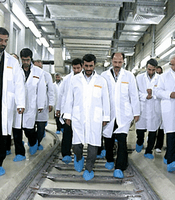On Oct. 19, at a multilateral meeting in Vienna focused on nuclear transparency, U.S. and Iranian representatives will meet for the second time in a month in the hopes of working out the modality by which the International Atomic Energy Agency (IAEA) will inspect Iran's newly revealed enrichment facility known as Fardo, near the holy city of Qom.
This particular issue is relatively straightforward, and the negotiations will likely result in the Fardo facility being placed under the IAEA's regular regime of inspections, already firmly in place with respect to Iran's other nuclear facilities. But it is nonetheless tied in with the more complicated issue of Iran's request for assistance with its medical research reactor in Tehran, which will run out of nuclear fuel by the end of 2010. The request was initially floated by Iranian President Mahmoud Ahmadinejad during his recent tour of the United Nations in New York.
Concerning the latter, the U.S., Russia and France, in coordination with the IAEA, have been secretly developing a plan for the delivery of high-enriched uranium (HEU) to the Tehran reactor for several months. Under the plan, which was broached at the last meeting with Iranian negotiators on Oct. 2, Iran would ship its stockpiles of low-enriched uranium to Russia for further refinement -- from 4 percent to the 20 percent required by the Tehran reactor -- with subsequent conversion to nuclear fuel cells taking place in France. The timetable and modality of the transaction, which has yet to be agreed upon, would be under the full aegis of IAEA.

